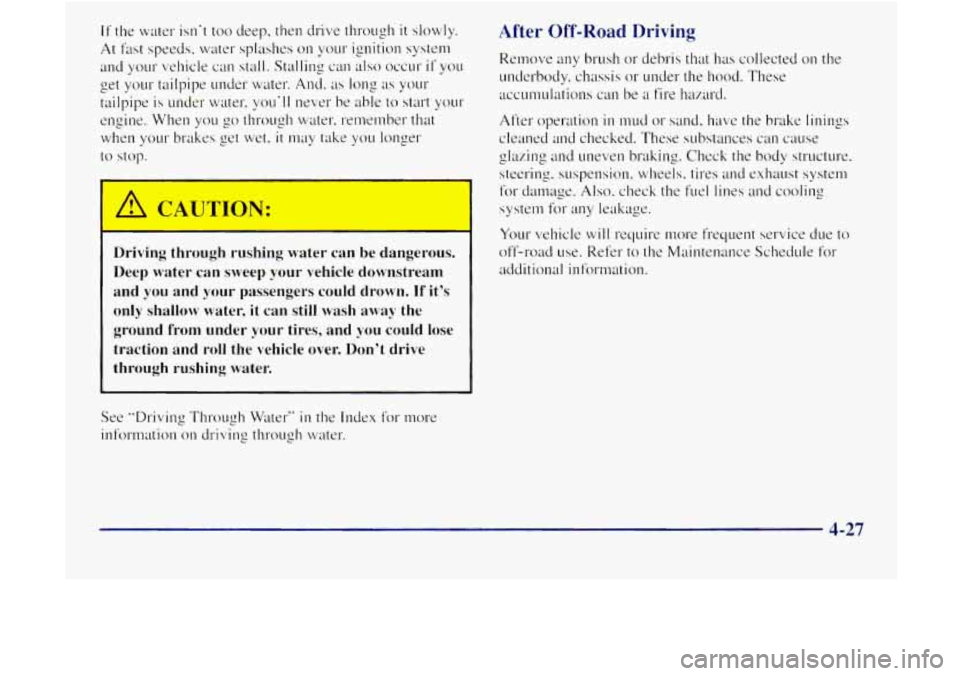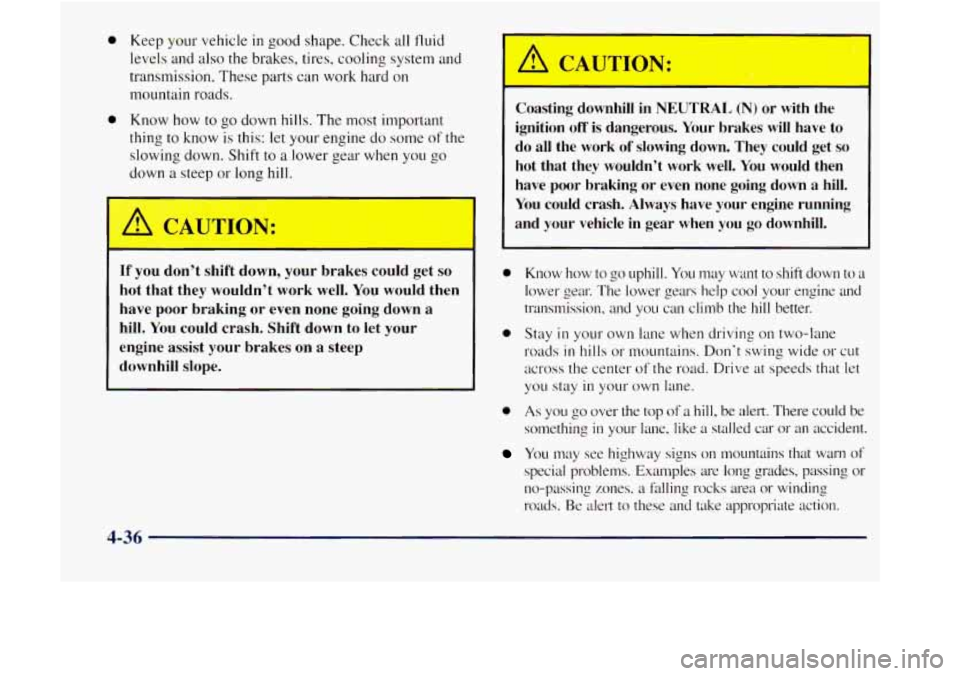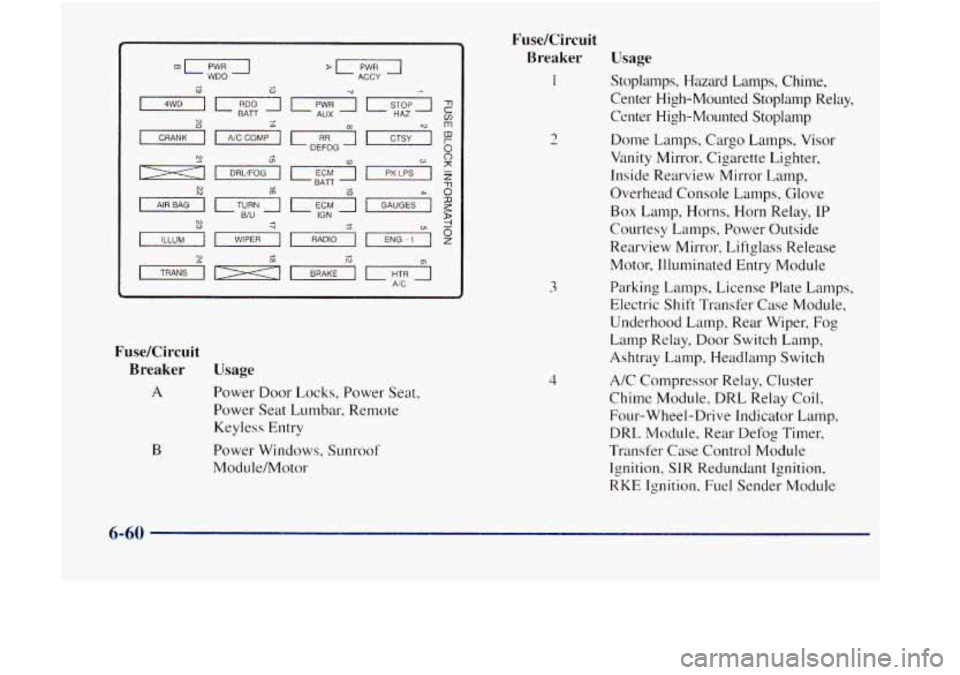ignition GMC JIMMY 1997 Owner's Guide
[x] Cancel search | Manufacturer: GMC, Model Year: 1997, Model line: JIMMY, Model: GMC JIMMY 1997Pages: 410, PDF Size: 20.03 MB
Page 192 of 410

If the water isn't too deep, then drive through it slowly.
At fast speeds, water splashes on your ignition system
and
your vehicle can stall. Stalling can dso occur if you
tailpipe is under water, yo~l*II never be able to start your
engine. When
you go through water. remember that
when your brakes get
wet. it nay take you longer
to stop.
2 wt your tailpipe under water. And. as long as your
Driving through rushing water can be dangerous. Deep water can sweep your vehicle downstream
and
you and your passengers could drown. If it's
only shallow water, it can still wash away the
ground from under your tires, and you could lose
traction and roll the vehicle over. Don't drive
through rushing water.
After Off-Road Driving
Relmove any brush or debris that has collected on the
underbody. chassis or 11nder the hood. These
accumulations CUI be a fire hazard.
After operation
in mud or sand. have the brake linings
cleaned and checked. These substances can C~LIS~
glazing and 1111even braking. Check the body structure.
steering. suspension. wheels, tires and exlxwst system
for damage.
Also. check the fuel lines and cooling
system for any leakage.
Your
vehicle will require more frequent service due to
off-road use. Refer to the Maintenance Schedule for
additional information.
4-27
Page 201 of 410

0
0
Keep your vehicle in good shape. Check all fluid
levels and also
the brakes, tires, cooling system and
transmission. These parts can work hard on
mountain roads.
Know
how to go down hills. The most important
thing to know is this:
let your engine do some of the
slowing down.
Shift to a lower gear when you go
down a steep or long hill.
If you don’t shift down, your brakes could get so
hot that they wouldn’t work well. You would then
have poor braking or even none going down
a
hill. You could crash. Shift down to let your
engine assist your brakes on
a steep
downhill slope.
A CAUTION: . -.
Coasting downhill in NEUTRAL (N) or with the
ignition
otf is dangerous. Your brakes will have to
do all the work
of slowing down. They could get so
hot that they wouldn’t work well. You would then
have poor braking or even none going down a hill.
You could crash. Always have your engine running
and your vehicle in gear when
you go downhill.
0 Know how to go uphill. You may want to shift down to a
lower gear. The lower gears help cool yo~~r engine and
transmission, and you can climb the hill better.
0 Stay in your own lane when driving on two-lane
roads
in hills or mountains. Don’t swing wide or cut
across the center
of the road. Drive at speeds that let
you stay
in your own lane.
0 As you go over the top of a hill, be alert. There could be
something
in your lane, like a stalled car or an accident.
You may see highway signs on nmuntains that warn of
special problems. Examples are long grades, passing or
no-passing zones. a falling rocks area or winding
roads.
Be alert to these and take appropriate action.
4-36
Page 206 of 410

Recreational Vehicle Towing (Four-wheel Drive With
7
Shift Transfer Case Only)
1.
2.
3.
3.
Set the par' * lg brake firmly.
Place an automatic transmission
in PARK (P) or a
manual transmission in FIRST ( I ).
Firmly attach the vehicle being towed to the tow
vehicle.
Do not tow the vehicle by the rear bumper
bar. Refer
to the hitch manufacturer's instructions.
Place the manual shift transfer case shift lever
in
NEUTRAL (N).
A CAUTION:
Shifting the transfer case into NEUTRAL (N) can
cause your vehicle to roll even if the transmission
is
in PARK (P), for an automatic transmission, or
if your vehicle is in gear, for a manual
transmission. You
or others could be injured.
Make sure the parking brake
is firmly set before
you shift the transfer case into
NEUTRAL (N).
5. Release the parking brake only after the vehicle
being towed is firmly attached
to the tow vehicle.
6. Insert the ignition key into the ignition switch and
turn
it one notch forward of the LOCK position. This
places the key
in the OFF position, which unlocks
the steering column while preventing battery drain.
Unlocking the steering column will allow
for proper
movement
of the front wheelshires during towing.
4-41
Page 225 of 410

2. Get the vehicles close enough so the jumper cables
can reach, but
be sure the vehicles aren*t touching
each other.
If they are, it could cause a ground
connection you don't want.
You wouldn't be able to
start your vehicle,
and the bad grounding could
damage the electrical systems.
You co~~ld
be injured if the vehicles roll. Set the
parking
brake firmly on each vehicle. Put an
automatic transmission in PARK (P) or a manual
transmission
in NEUTRAL (N). If you have a
four-wheel-drive vehicle with a manual transfer case
shift lever, be sure
the transfer case is not in
NEUTRAL (Nj.
3. Turn off the ignition on both vehicles. Unplug
unnecessary accessories plugged into the ci, wsette
lighter, or accessory power outlets,
if you have this
option. Turn off all
lamps that aren't needed as well
as radios. This will avoid sparks and help save both
batteries.
In addition, it could save your radio!
I NOTICE:
If' you leave your radio on, it could be badly
damaged, The repair wouldn't be covered by
your warranty.
An electric fan can start up even when the engine
is not running and can injure you. Keep hands,
clothing and tools
away from any underhood
electric fan.
- -
If your vehicle has air conditioning, the auxiliary
electric fan under the hood can start up
even
when the engine is not running and can injure
you. Keep hands, clothing and tools away from
any underhood electric fan.
5-4
Page 230 of 410

When your vehicle is being towed. have the ignition key
turned to the OFF position. The steering wheel should
be cla111ped
in a straight-alwad position with a clamping
device designed for towing service. Do not use the
vehicle's steering column lock for this. The transmission
should be
in NEUTRAL (N) and the transfer case, if you
have one. should be in 2HI. The parking brake should
be released.
If your vehicle 11as a floor mounted shifter and no
electrical power, the electrical solenoid lock must be
overridden to shift from PARK (P) to NEUTRAL (N).
Follow these steps:
1. Push the base of the shift lever boot forward \%7ith
your tlwmb.
2. Lift the boot and find the white solenoid lever.
3.
4.
5.
Move the solenoid lever toward the driver's side to
unlock
it.
While holding the solenoid lever in the ~~nlock
position. press the shift lever button and shift into
NEUTRAL (N).
5-9
Page 319 of 410

,I,, WDO >- ACCY
Fuse/Circuit Breaker
Usage
A Power Door Locks, Power Seat,
Power Seat Lumbar, Remote Keyless Entry
Power Windows, Sunroof
Modde/Motor
B
Fuse/Circuit
Breaker Usage
1
2
3
4
Stoplamps, Hazard Lamps, Chime,
Center High-Mounted Stoplamp Relay,
Center High-Mounted Stoplamp
Dome Lamps, Cargo Lamps, Visor
Vanity Mirror, Cigarette Lighter,
Inside Rearview Mirror Lamp,
Overhead Console L,amps, Glove
Box Lamp, Horns, Horn Relay, IP
Courtesy Lamps, Power Outside
Rearview Mirror, Liftglass Release
Motor, Illuminated Entry Module
Parking Lamps, License Plate Lamps,
Electric Shift Transfer Case Module,
Underhood Lamp, Rear Wiper,
Fog
Lamp Relay, Door Switch Lamp,
Ashtray Lamp, Headlamp Switch
A/C Compressor Relay, Cluster
Chime Module. DRL Relay Coil,
Four-Wheel-Drive Indicator Lamp,
DRL Module, Rear
Defog Timer,
Transfer Case Control Module
Ignition, SIR Redundant Ignition,
RKE Ignition. Fuel Sender Module
6-60
Page 320 of 410

Fuse/Circuit Breaker Usage
5
6
7
8
9
10
11
12
13
14
1s
Oxygen Sensor Heater, Exhaust Gas
Recirculation, Cam Sensor, CANN.
Purge. Canister Vent Solenoid. Mass
Airflow Sensor,
Cam Shaft Sensor
Blower Motor, Temperature Door Motor.
HI Blower Relay Coil
Power Auxiliary Outlets, Assembly
Line Diagnostic
Link
Rear Window Defogger
PCM/VCM Battery. Fuel Pump
PCM/VCM Ignition, Injectors. Crank
Sensor. Coil Driver Module
Radio, Inside Rearview Mirror Map
Lamp, Overhead Console Reading
Lamps. Rear Wiper, Rear Washer.
Overhead Console Display
Anti-Lock Braking System. VCM
IGN-3
Clock. Radio Battery, CD Player
A/C Compressor Battery Feed
Daytime Running Lamps, Fog
Lamps,
Fog Lamp Relay
17
18
19
20
21
22
23
Fuse/Circuit
Breaker Usage
16 Turn Signals and Back-up Lamps,
Brake-Transmission Shift Interlock
Solenoid
Windshield Washer, Windshield Wiper Motor
Not Used
Electric Shift Transfer Case
Crank Relay,
Air Bag Module
Not Used
Air Bag Module
Cluster Hlumination, Radio
Illu~nination. He.ater Lamp.
4WD
Illumination, Chime Module, Fog
Lam13 Illumination, Rear Wiper
Switch Illumination, Rear Defogger
Switch Illumination, Liftglass
Release Switch Illumination,
Overhead Console Illutnination
PRNDL Power. 4L60E Automatic
Transmission
24
6-61
Page 372 of 410

Ignition Transmission Lock Check While parked, and with
the parking brake set, try to turn
the ignition key to LOCK
in ex11 shift lever position.
0 With an automatic transmission. the key should turn
to LOCK only when the shift lever is in PARK (P).
With a manual transmission, the key should turn to
LOCK only when the shift lever is in REVERSE (R).
On vehicles with a key release button, try to turn the key
to LOCK witl~out pressing the button. The key should
turn
to LOCK only when you press the key button.
On all ve.hicles, the key should come out only in LOCK. Parking Brake and Automatic Transmission
PARK
(P) Mechanism Check
CAUTION:
--
When you are doing this check, your vehicle
could begin to move.
You or others could be
injured and property could be damaged. Make
sure there
is room in front of your vehicle in case
it begins to roll. Be ready to apply the regular
brake at once should the vehicle begin
to move.
Park
on a fairly steep hill. with the vehicle facing
downhill. Keeping your
foot on the regular brake. set the
parki ng brake.
e To check the parking brake's holding ability:
With the engine running and transmission
in
NEUTRAL (N). slowly remove foot pressure from
the regular brake pedal. Do this until the vehicle is
held by the parking brake only.
e To check the PARK (P) meohanisrn's holding ability:
With the engine running, shift to PARK (P). Then
release
al I brakes.
7-49
Page 398 of 410

Garage Door Opener ............................ 2-5 1
GasCap ....................................... 6-5
Gate Ajar Light ................................ 2-81
GAWR ....................................... 4-43
Gear Positions
................................. 2- 18
GIov~ BOX .................................... 2-50
Gross Axle Weight Rating
........................ 4-43
Gross Vehicle Weight Rating
...................... 4-42
Guide en Franqais
11
GVWR ....................................... 4-42
.. .................................
Halogen Bulbs ................................ 6-33
Hazard Warning Flashers
.......................... 5-2
Head Restraints ................................. 1-6
Headlamps .................................... 2-35
Bulb Replacement ............................ 6-33
High/Low Beam Changer
...................... 2-39
On Reminder
................................ 2-46
Wiring
..................................... 6-59
Hearing Impaired. Customer Assistance .............. 8-4
Heating ........................................ 3-3
Highway Hypnosis .............................. 4-35
Hill and Mountain Roads
......................... 4-35
Hitches. Trailer
................................. 4-48
Horn
......................................... 2-37
Hydraulic Clutch
............................... 6- I9
Hydroplaning .................................. 4-3 I
Hood .......................................... 6-6
Check
...................................... 7-47 Ignition
Positions ..............................
Brake System ................................
Suspension .................................. 7-50
Throttle Linkage
.............................. 7-50
Transfer Case
................................ 7-51
Instrurnent Panel
............................... 2-67
Cleaning
.................................... 6-52
Cluster ..................................... 2-69
Interior Lamps
................................. 2-47
Exhallst
Systems
............................. 7-50
Steering
.................................... 7-50
F~seBlock
.................................. 6-59
Jacking Equipment
............................. 5-26
Jump Starting
................................... 5-3
Key
in the I.ylilion ............................. 2-12
Key Lock Cylinders Service ...................... 7-47
Key Release Burton
............................. 2-15
Keyless Entry System ............................ 2-6
Keys .......................................... 2-2
9-5